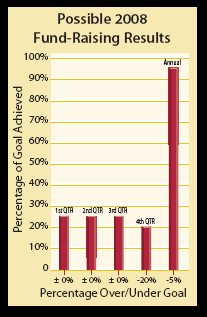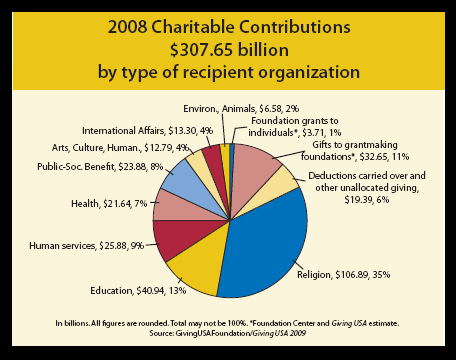Americans gave an estimated $307.65 billion to charity in 2008, according to figures recently released in Giving USA 2009. This 2% drop in giving, which amounts to 5.7% when adjusted for inflation, represents the first decline in charitable giving in current dollars in over 20 years and the largest fall in inflation-adjusted dollars in Giving USA history.
Given the economic downturn that began in 2008, this decline in charitable giving should come as no surprise. As Giving USA reports, a number of key economic indicators were down, especially in the fourth quarter of 2008. Significant declines in the gross domestic product (GDP), stock market, and real estate values contributed to an economic environment unfavorable to charitable giving.
A drop in charitable giving of almost 6%, while significant, may seem mild compared to the losses seen in the stock market and other segments of the economy in 2008. It is important to recall that, while economists in hindsight believe the current recession began in 2007, most Americans did not feel the full brunt of the recession’s impact until late 2008. It was also not until the second half of the year, and especially the fourth quarter, that the media began discussing the bad economic news almost daily. A plummeting stock market in the fourth quarter contributed to a distinctively negative environment for fund raising in the fourth quarter.

As a result, many charities may have actually met or even exceeded their goals for the first two or three quarters of 2008 before experiencing a sudden drop in gifts in the last quarter. For instance, suppose an organization had a goal of raising $1,000,000 in 2008, or $250,000 per quarter on average. This organization could have met its goal in the first three quarters, raising the projected $750,000. This same organization could then have seen a 20% drop in giving in the fourth quarter and raised only $200,000. Despite the 20% decline in the fourth quarter, the organization would have seen only a 5% drop for the entire year.
Many organizations may have faced similar fund-raising challenges in the opening months of 2009 as well. If an organization saw a 20% decline in the first quarter of this year and has normal results for the remainder of the year, it would be down only 5% for 2009 as well. Looking backwards, however, the organization would have had two years of results that were down 5% in total, while experiencing a six-month stretch when giving was down 20%. In this case, the annual reports would not accurately reflect the actual experience of those charged with raising funds over the two years in question.
A look at the numbers
Among the major findings in the Giving USA report is a drop in giving by individuals, a source that accounts for 75% of total charitable giving. Figures for individual giving include estimates of giving by itemizers and non-itemizers alike. For purposes of the report, individual giving is defined as monetary gifts as well as non-cash gifts such as used clothing and other items.
Individual giving in 2008 is estimated at almost $230 billion, a decline of 2.7% (6.3% when adjusted for inflation). Despite the decline, individual giving is still within reach of levels seen from 2004 to 2007, when totals ranged from $230 to $245 billion (in inflation-adjusted dollars).
Bequests and corporate giving are also reported to have declined in 2008. Bequests saw a decrease of 2.8% (6.4% in inflation-adjusted dollars), while corporate giving experienced a 4.5% drop (8.0% when adjusted for inflation).
Even though charitable bequests were reported “down” after revising the previous year’s estimate upwards, the $22.66 billion contributed by bequests in 2008 was the third-highest bequest figure recorded for a single year. As bequests are not generally tied to short-term economic performance, the slight drop in bequests is primarily attributable to two factors: lower death rates in recent years due to increased longevity and a 25% decline in births during the ten-year period from 1925 to 1935 (roughly the 74 to 84 age range today). Note also that Giving USA typically initially reports a conservative figure that does not include estimates for unknown “mega bequests” that are accounted for in future revisions when additional data is released from the IRS.
Despite the decline in 2008, bequest giving remains a strong and reliable source of income for many nonprofits. In fact, more funds have come in the form of bequests in the last 5, 10, 15, and 20-year periods than have resulted from any comparable periods in the past.
Foundation grantmaking saw a 3% increase in current dollars (or a 0.8% decline when accounting for inflation). Grants from foundations have risen 18% over the past three years, fueled in part by a rise in stock market values prior to the fall of last year and increased funding of foundations provided by large bequests in recent years.
Where the money goes
Religious organizations benefited from almost 35% of total giving in 2008. The $106.89 billion figure represents a growth of 1.6% over 2007 numbers. Educational organizations saw a drop of 9% from 2007 yet still received 13% of total charitable giving (all figures have been adjusted for inflation).
Foundations represent 11% of charitable gifts in 2008, followed by human services organizations and public-society benefit organizations at 8% to 9% each. Compared to 2007 figures, foundations saw a drop of 22.2% while human services organizations fell by 15.9% and public-society benefit organizations rose by 5.4%.
Only three types of organizations saw an estimated increase in giving in 2008. Those organizations whose missions fall in the religious, public-society benefit, and international affairs subsectors managed to grow in 2008. When adjusted for inflation, however, only religious and public-society benefit organizations saw a rise in giving over 2007 figures.
Putting it in perspective
Giving USA also provides historical data that helps put 2008 figures in their proper context. Viewing figures in five-year clusters makes it easier to see trends in giving and may provide more useful information in the long term.

Charitable giving over the past five years totaled $1,568.28 billion, an 11.4% rise over the previous five years and more than any other five-year period.
Although many types of organizations declined in 2008, every subsector saw growth in giving in the last five years.
Giving USA also compares charitable giving to the gross domestic product (GDP). Giving in 2008 totaled 2.2% of the GDP, slightly less than 2007’s figure of 2.3% but right on track with the average of the last ten years.
Looking ahead
What does this mean for organizations as they pursue their goals for 2009? To be sure, America is still in the midst of a recession. Many of the nation’s nonprofits struggled to meet fund-raising goals in the fourth quarter of 2008 and again in the first quarter of 2009.
Yet indications are good that the economy is slowly improving. Some economists predict that the recession will end some time this year. The six-month period from October 2008 to April 2009 may in retrospect reflect the worst of the recession’s effects.
If so, nonprofits may still be able to salvage satisfactory fund-raising results for this year. Time will tell, but the losses many experienced in the first quarter of 2009 may be offset by stronger results in the remaining months of the year.
Provide alternative gifts
In the meantime, it is important to do everything possible to retain current donors and help them give in ways that make sense for them in this climate. Maintaining contact with donors through year-end appeals with helpful information about the best ways to make gifts can help ensure successful fund raising this fall and beyond.
Remember to encourage donors to consider alternatives to immediate cash gifts. Many types of gifts offer special appeal in the current economy. See “The Best Gifts for Today’s Environment” in the June 2009 issue of Give & Take for ideas (available at www.sharpenet.com/gt).
A full report of Giving USA 2009 may be obtained from the Giving USA Foundation at www.aafrc.org.
Note: The Sharpe Gift Planning Institute offers a number of training opportunities for development executives. Sharpe seminars provide a chance to benefit from the experience of some of the nation’s top professionals in the field, many of whom have weathered similar economic downturns in the past. See page 3 or visit www.sharpenet.com/seminars for more information.

